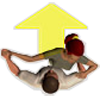Alignments
Alignment refers to the direction the feet point in relationship to the room.
The 3 major points of reference in the room are the line of dance, the wall, and the center.
Hover your mouse near a green button to view man's and lady's alignments:
Line of Dance
Wall
Center
| Man is: | Facing line of dance |
| Lady is: | Backing line of dance |
The Wall
Most room have four walls, but the wall that is referenced when discussing alignments is
the wall closest to the dancers as they move along the line of dance. Because the line of
dance is counter-clockwise, the wall will always be at your right-hand side when you are
facing the line of dance.
The Center
There are two centers in the room: (1) True center, which is the actual center point in the
room, and (2) relative center, which is the alignment directly opposite the wall. No matter
where you stand in the room, if you face the line of dance, the relative center will be at
your left-hand side. Alignments, as they are written in the syllabus, always refer to relative
center (which is usually referred to simply as "center").
Facing, Backing, Pointing
In addition to indicating the direction of the feet, alignments may also refer to the
orientation of the body or even the direction the body is traveling. When feet are pointing
straight ahead and the direction of movement is forward (straight or diagonally) or side,
the alignment is referred to as "Facing..." (eg "Facing Line of Dance").
When the feet are pointing straight ahead but the body is moving backward (straight or
diagonally), the alignment is referred to as "Backing..." (eg "Backing Center").
When the feet are turned to an alignment different than the body, it is referred to as
"Pointing to" (eg "Pointing to Wall").
Note that in the diagram above, the yellow arrow indicates the direction of travel, which for
simplicity's sake is always shown pointing toward where the man is facing. As a result, the man in the
diagram is always facing, and the lady always backing. However, in a real world application,
the man could also be backing while the lady is facing, if the direction of travel reverses.
The man and lady could also both be facing or backing simultaneously, if dancing in other positions
such as promenade or shadow.

